
This lecture will teach you how to create an efficient file naming protocol for and why it is so important.
We will explain what are the essential elements of a good file name and how to create simple rules that everyone in your team will easily understand and implement.
These rules need to take into account the content of your file, the meaning of the file name, but also its format.
Why does file naming need to be so consistent and why should you – an online employee – do your best to keep it that way?
First of all, it makes your work a lot easier and makes you more productive. In time, as the company grows, you will see just how many files will be piling up. You will be swamped in hundreds or even thousands of different reports, image files, video files, logos, banners, invoices, reports, tables and presentations.
If you don’t have a consistent system of naming those, imagine how hard it would be to find that invoice you need from March, last year. Moreover, if you are doing some design work, how many image files you need to open until you find that last version of your company logo that you need this moment!
Secondly, consistent file naming protocol makes it easier to collaborate. Whether you are a copywriter, virtual assistant or web designer, you are creating a certain amounts of files in your company that other people need, as well.
If you all use the same naming system, your coworkers will easily find the file they need, even though they haven’t created it, but you did. This will save their time and yours.
It is especially important if somebody from the company is absent. If they use file naming protocol that only they understand, it is next to impossible for their substitute to find their way around their files and folders and that puts the entire company operation to a halt.
Imagine that you are new to the company, you are scheduled to have a meeting and they want you to present them with the invoices from march 2016.
Or, let’s say it is your first day on the job and your coworker asks you to find them a version of your company’s logo that is larger than 800 pixels.
Would you be able to understand which of these files you need to use?
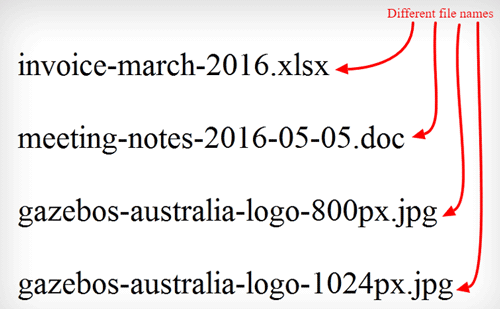
Would it take you more than a minute to realise which files you need? Of course not. These are easy to search even if you are still not very well acquainted with the way things work.
On the other hand, would you be able to do the same in such a short period of time, if the file names looked like this?
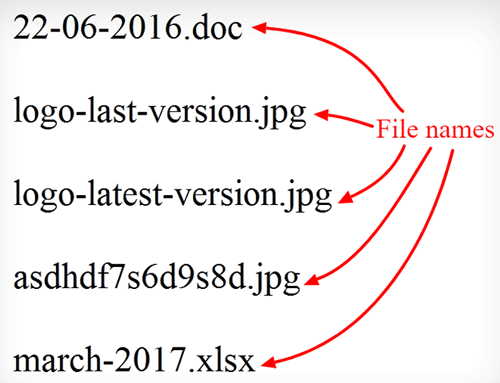
Of course you wouldn’t. You would have to open every single one of these files to figure out what is inside them. Moreover, would you even be able to choose a file that contains the most recently updated image of the company logo? Is the last version? The latest version? Who knows!
Sometimes, it is good to see how others name their files. You can easily inspect the way they name their image files by visiting their websites and opening their image in a separate tab.
Let’s take a look at how The Oil Collection names their product images on their website. This process can be used for any other website, as well.
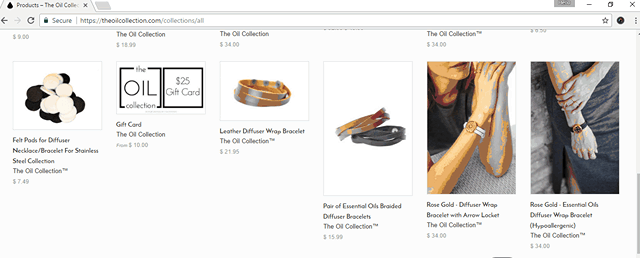
Remember – sometimes platforms like Shopify and BigCommerce change the image file name a bit, usually by adding some elements of their own. However, it is not that hard to figure out the original file name.
Before reinventing an entire file naming protocol in your new company, ask your employer if they already have a file naming system that they use. If they do, take the time to master it and respect it every time you make a new file.
If they don’t – it is your time to shine, because it is your chance to introduce an efficient file naming protocol that will save your employer a lot of time and effort and make the file organisation neat and effective.
Still, in order for such a system to truly work, everybody in the company needs to follow the convention. That means you should talk to your employer first, before undertaking such a project.
If you get the green light to come up with a set of file naming rules, here are some of the points you should incorporate into your protocol.
Rules Concerning File Name Meaning
Before you start creating a file naming protocol for make sure that you take these rules into consideration. When file names mean something to a person, they are more likely to remember it and to search for it.
Consider Your Business Thought Process
Different companies have different processes going on. Consequently, what is important when it comes to file names in one company will be completely insignificant in another.
For example, let’s say you work for an online store that sells glasses that help colour blind people. You may have several types of glasses, but it is basically the same product in different styles.
There is no point in adding the words “glasses” in every file name. You can just include the distinctive features of the glasses, like model and colour.
You can even add the image size because it is relevant for your business process – creating product pages.
Something like Enchroma did with their image file names. Take a look at their products, and then we’ll see how they named their image files:
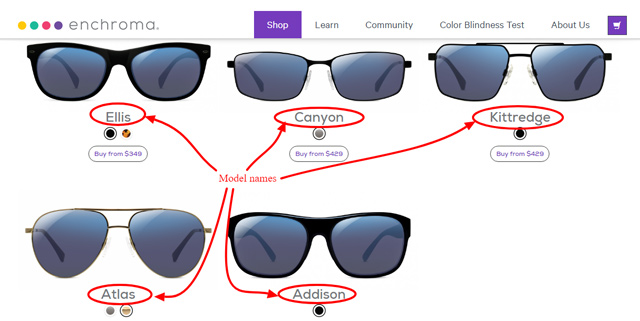
When you open images of all these products in different tabs, you will discover the following file names:
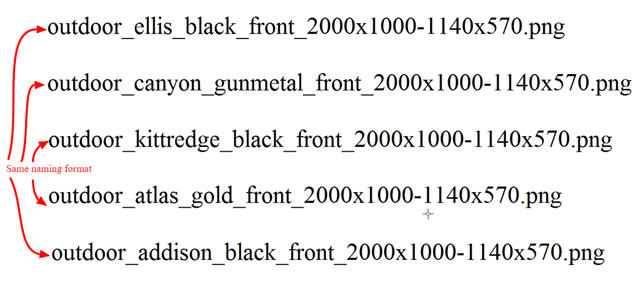
It is obvious that all the file names follow the same pattern. They begin with the model type, followed by the model name and then some specifics about the image itself: position and possibly image dimensions.

This information is important for the business flow of this online store. They sell glasses that help colour blind people and they have glasses that are worn indoors and outdoors. Therefore, the first item in the file name is that classification. It is relevant information for their business process.
After that, all the information included in the file name goes into more specifics, but all those specifics give out information that make the images useful and quickly searchable by the online employees: model name, position or angle of the image and she specifics of the image file.
On the other hand, Alpha Clothing offers different types of sports clothing items: hoodies, joggers, shorts and many more. Therefore, their image files will have to disclose much more than just a model name.
Let’s take a look at their product page:
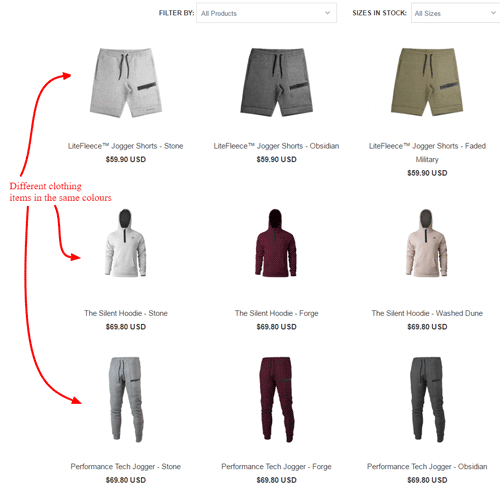
They sell jogger shorts, hoodies and jogger pants. Therefore, the filename has to denote which type of product class is on the image. Just a model name or a colour are not enough anymore.
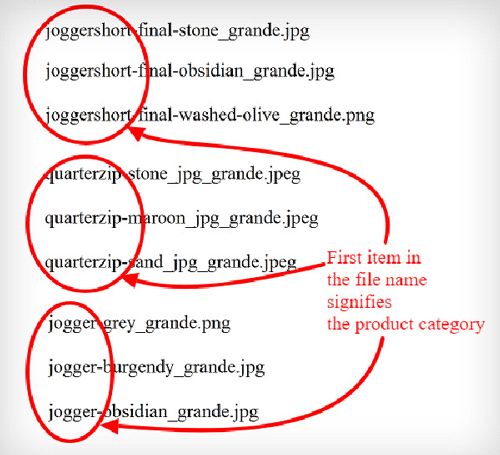
Think about what are the most important facts that a file name needs to disclose to a person from your company and use it for your file naming.
Be Descriptive and Indicative
Having file naming protocols is meant to speed up your searches and make it easy to find files you need. For that to work, your file names need to disclose what is in the file in a matter of seconds. Your entire file naming system is not good if you still waste time opening files one by one to see what is inside.
Make sure that your file names are descriptive and indicative but still reasonably short. To achieve that, you will need to come up with some sort of abbreviation system, like IN for invoices, UB for utility bills. Naturally, they need to be relevant for your business and obvious to your coworkers.
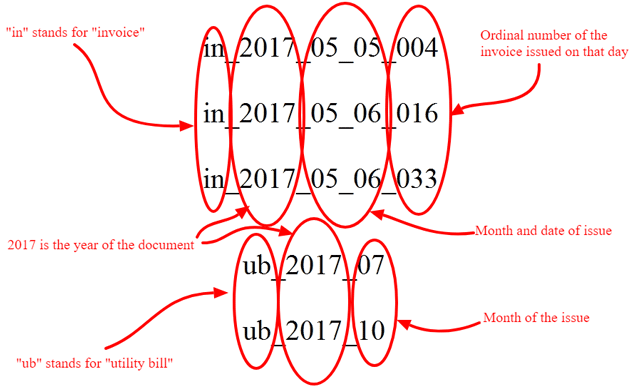
While the invoices are issued on a daily basis, they need to have an ordinal number at the end. If you are a part of a wholesale then you may want to include the customer’s name instead.
On the other hand, if the utility bills are received each month, including just the year would not narrow down the list. Also, you are hardly to receive bills for several days of a month, so including a year and a month is enough.
Bee Friendly is an eCommerce store that sells organic skincare products. Their file naming protocol when it comes to images is very descriptive and it is obvious to anybody what is on the image without even opening the file. The file names are also of a reasonable length.

Here is another example of how an online company names their image files. This is an example of The Beltman and their keychain collection.
What do you think about these file names?
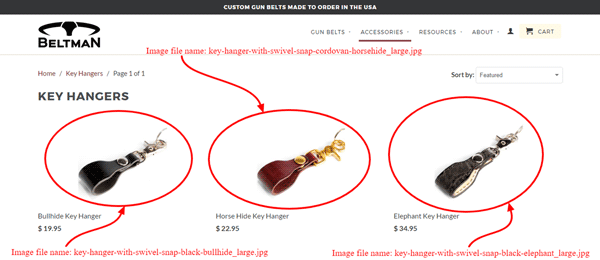
They are very descriptive and indicative, but they are a bit long. They could probably be shortened by eliminating the words like “with” or using abbreviations for the words that get repeated all the time or those that are obvious.
Make the File Names Unique
Each file name needs to be different. Firstly, this needs to happen to avoid misunderstandings and to prevent doubling the files. Secondly, you won’t even be able to save a file if there is another one with the same name.
There is a simple hack when it comes to coming up with unique file names: simply add a date or a version. When you add dates, add them in the format YR MO DA (year, month, day) so that computers list them in order easily.
Let’s go back to those invoice file names from before and see how this works in practice:

There may be hundreds of invoices that have been issued in 2017, but only a limited number of them have been issued in May. Moreover, even less is issued on a particular day (in this case the 5th or the 6th of May). The last number pinpoints the exact invoice issued that day – and that can be only one.
Now, let’s examine that last, ordinal number within the invoice. Why 004? Why not just 4?
When you are adding a version, think about how many versions are you likely to have. Is it more than 9? More than 99? This will help you make the choice between putting your version number in format 01, 02, etc or 001, 002.
Therefore, in the case of this particular store, it is likely that they expect to have days when they will be issuing more than 100 invoices a day.
This is a nice way to make the file names unique if you have files that can be marked by dates. If you want to store product photos and name them properly, including a date will not do much good. You’ll have to find a different way to make the file unique.
Emazing Lights created unique file names for their product images. Here is the web page of their bandana collection and the image file names listed besides respective items.

Each of these file names contains distinctive features of what is on the image. The “HarleyQuinn” and “CamoCats” parts describe the collection of bandanas, “SeamlessMask” narrows it down even more. Words “Front” and “large” are about the position and the size of the image.
However, words “Classic”, “Split”, “RedSuits” are what make those file names unique. In combination of words that denote the collection and the type of bandana, this one word is enough to pinpoint the image a person is looking for.
On the other hand, I Heart Dogs used a file naming system that can prove itself to be a bit problematic on the long run. At this point, the image file names are probably unique in a way, because it would not be possible to save two files with a same name on the same drive, but they are not unique or distinctive. Take a look:
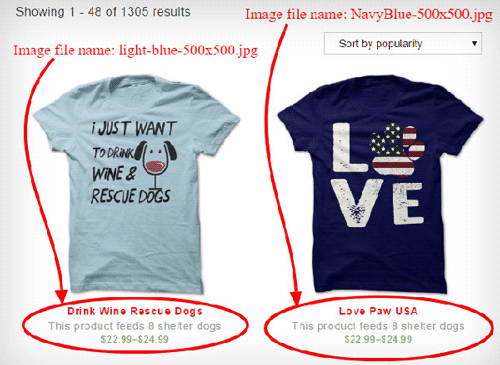
If you open the link above and take a look at I Heart Dogs product range, you will see that there are many products that are light blue or navy blue. Therefore, these image file names are not unique or distinctive enough and should be improved.
Do you have any ideas?
ts-light-blue-drink-wine-rescue-dogs-500×500.jpg
ts-navy-blue-love-paw-usa-500×500.jpg
These two, where “ts” is short for “T-shirt” might be far more effective.
Be Consistent
This one is pretty much self-explanatory. Once you decide on the file naming system, stick to it. Be consistent and diligent about it. Otherwise, there is no point of having such a system in the first place.
Let’s say you agreed, on a company level, that you will use the format for your invoice files that goes like this: in_year_month_day_ordinal number. As we already showed, it would look like this:

However, what if there was no consistency and people switched back and forth between putting the month before the day and putting day before the month?
It would create a great confusion and it would be impossible to be sure if the invoice is from 3rd of June or 6th of March. Like this:
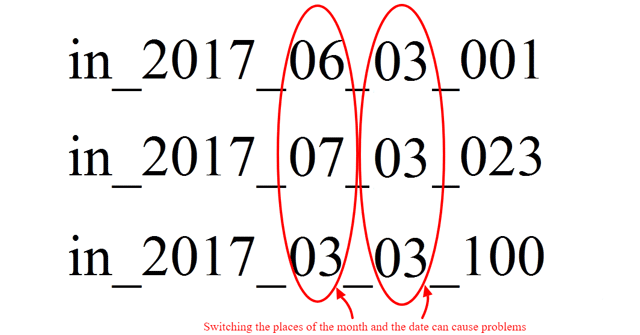
For this type of issues to be avoided, there has to be consistency in your file naming protocols.
Now that we checked the example of invoices, let’s see the image file name examples from the eCommerce companies.
Golden Moon Tea puts the name of the product first, then colour and then the image size:
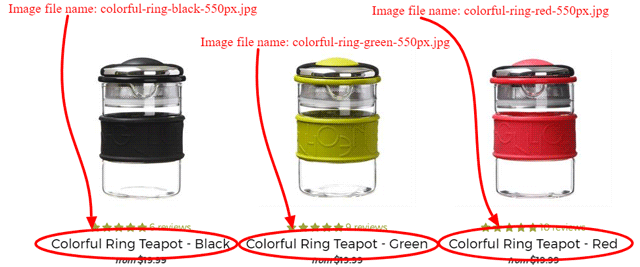
Titanium Buzz doesn’t always have consistency in naming their image files. Take a look at this screenshot with the image file names linked to images.
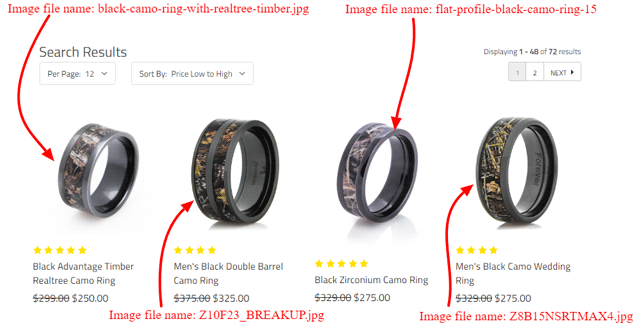
Your rules can be better or worse. They can be improved in time, but one thing is for sure – if they are not consistent, they are not useful to you.
Rules Concerning File Name Format
How you organise the elements of your file names is just as important as what does elements/words mean. This organisation of the file name elements is the file name formatting.
It is important because it can make your file names more searchable and your work more productive and better organised. When it comes to file name formatting rules, here are some guidelines that will definitely help you create a great system.
Go From General to More Specific
In order to make the file name indicative and descriptive, it will have to contain certain information about its content. That information can be more general or more specific in its nature. For example, let’s say that you are naming files containing product photos for an eCommerce store.
You can start by using some more general information like stating that it is a product photo, since you are likely to have many image files – logos, banners and many more.
A more specific information would be the product line or collection and the model name. The last and the most specific info can simply be size of the image, either in form of pixels or just large/small. Of course, you can just add the image number to differentiate between them.
Hotmix, for example, has product pages that contain several images of the same product. Their filing convention includes naming images according to the product name and adding an ordinal number to the image file.

If we take a closer look at any of these file names and break them down into elements. The information goes from the most general to the most specific.
The part breton-buzz-womens-cycling-jersey is the most general piece of information. It is the same for all images for that product. Most of those images have one dimension that is 800px. That is the more specific piece of information.
The most specific pieces of information are the other image dimension and the ordinal number of the image.

The same principle can be used when you name other types of files, as well. Invoices, bills, reports and other types of documents that every eCommerce store has.
Truth be told, it is fairly obvious, by looking at the file extensions like: JPG, PNG, BMP that those files contain images. That can narrow down your search. However, that is not the case with other types of files that are in spreadsheets, text documents or PDF files.
Therefore, a smart thing to do is to include that information as the most general one in your file name.
Let’s go back to the example with invoices and adding dates to them.

The in stands for invoice and that is the most general information. The year is still very much general since there are many invoices issued by an eCommerce store every year.
The more specific details include the month and the day, while the most specific piece of information is the ordinal number of the invoice issued on that very day.
Use Lower Case
By using the lower case letters for your file names, you are avoiding the possible confusion that may occur. Namely, Microsoft systems don’t make the difference between the lower case and the upper case letters. File_Name and file_name are the same to those systems.
Linux, on the other hand, sees the difference between these two. The problem is, most of the online systems are based on Linux. As you can see, if these two operating systems come into contact, and they do, it may influence the way your files are stored.
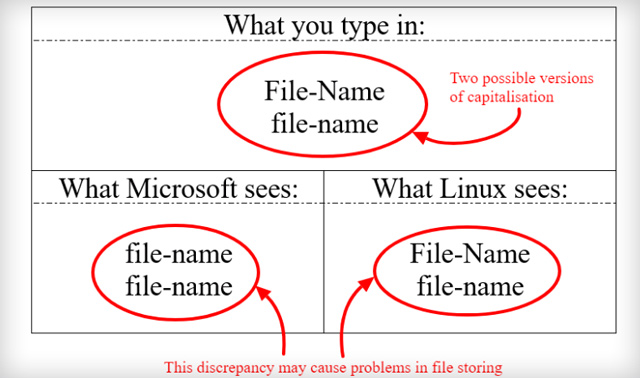
Therefore, if you have two file names, one capitalised and the other one all in lowercase, you should know that the Microsoft systems will see it as the same file name and ask you to change the name for one of those files.
No Spaces
Your file names should not contain spaces. Instead of using those, you should choose between an underscore or a hyphen. For example, instead naming your file: file name, name it file_name or file-name.
This prevents issues with operative systems and the way they perceive your files. Similarly to the issues that can happen if you use capital letters.
If you want to know more about why the space should be avoided, read the Blackbaud Know How article about it.
There are also some interesting answers to the question of space in file names on Quanda.
No Special Characters
Another thing that you should avoid for all the same reasons are the special characters. Stick to the alphabet and numerals and avoid things like : ; * !@#$%^&*() and the like.
File names, special characters, and file type limitations in your #SharePoint intranet, by SP version. #IntranetNowhttps://t.co/agxztCrZeV pic.twitter.com/BN9e0ZHNO2
— jumpto365 (@jumpto365) September 30, 2016
Test Your File Naming Convention
Many eCommerce workers use this simple, yet effective test to see if their file naming convention is successful.
Here it goes:
- Namely, you have to imagine that you have taken all the files from your entire organisation and put them all in one folder.
- How hard would it be to find a single file in that folder? Would you be able to scroll directly to it? Could you find it by searching a part of a file name?
Positive answers to these questions mean that you have a good file naming practice. If not, you need to improve it by incorporating the tips and rules from above.
Let’s say you have concluded that you need to change the file naming convention and improve it. You will still get stuck with all the previously named files that don’t follow your newly created file naming convention.
You need to rename those old files, but doing it one by one is a tedious and time consuming task. Luckily for you, you are not the first one with this problem and people have created the file renaming tools.
Renaming Tools
Among the most important things about the file naming conventions is that you have to be consistent and that everybody in the eCommerce company needs to stick to the conventions. Otherwise, they will be of no use, since the file names with different conventions will not be as searchable and as convenient to use.
Bulk Rename Utility – free tool that allows you to rename files in a bulk, change cases, add numbers automatically and even input your own convention. Unfortunately, it is not available for DOS, Linux and Mac.
Renamer – tool created for renaming files for Mac systems. It has many useful features and even pre-formulated file naming protocols for you to choose from.
PSRenamer – allows you to change a part or the entire file name. Besides the usual bulk renaming feature, you can also change even just certain characters within the already existing file names.
In Summary
It is likely that your company already has a file naming policy. If it doesn’t, come up with a solid one in cooperation with your employer.
It is essential for an eCommerce employee to be able to create and follow proper file naming protocols. That makes the entire file management practice faster, more efficient and which translates to better and improved productivity of any eCommerce store.
If you want a successful career in eCommerce, you have to realise the benefits of consistent file naming protocols and master their implementation. These protocols make your work more efficient, collaboration within your team more effective and the overall file management more productive.
Your file naming strategy should follow a couple of rules that deal with the filenames and the format of those names:
- File naming should be relevant to your business
- Be indicative and descriptive
- Each file name should be unique
- Be consistent with your file naming
- Go from general to more specific info in your file names
- Use lower case
- Don’t use spaces or special characters
Frequently Asked Questions
1. Which one of the following file names is the best option
a. File_name
b. file_name
c. FileName
d. file name
2. When should you go on and create a file name rules?
a. As soon as you join a company. No time to waste!
b. You can make it for yourself, but do in on a company scale only if you agree on that with your employer
3. Using special characters in file names is:
a. To be avoided
b. Great way to make unique file names
